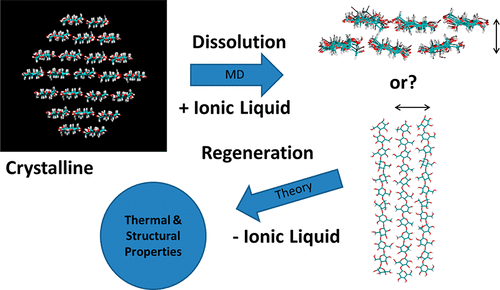当前位置:
X-MOL 学术
›
Biomacromolecules
›
论文详情
Our official English website, www.x-mol.net, welcomes your
feedback! (Note: you will need to create a separate account there.)
A Hierarchical Model To Understand the Processing of Polysaccharides/Protein-Based Films in Ionic Liquids
Biomacromolecules ( IF 5.5 ) Pub Date : 2018-08-21 00:00:00 , DOI: 10.1021/acs.biomac.8b00903 Amnah Hadadi , John W. Whittaker , David E. Verrill , Xiao Hu 1 , Luca Larini , David Salas-de la Cruz
Biomacromolecules ( IF 5.5 ) Pub Date : 2018-08-21 00:00:00 , DOI: 10.1021/acs.biomac.8b00903 Amnah Hadadi , John W. Whittaker , David E. Verrill , Xiao Hu 1 , Luca Larini , David Salas-de la Cruz
Affiliation

|
In recent years, biomaterials from abundant and renewable sources have shown potential in medicine and materials science alike. In this study, we combine theoretical modeling, molecular dynamics simulations, and several experimental techniques to understand the regeneration of cellulose/silk-, chitin/silk-, and chitosan/silk-based biocomposites after dissolution in ionic liquid and regeneration in water. We propose a novel theoretical model that correlates the composite’s microscopic structure to its bulk properties. We rely on modeling non-cross-linked biopolymers that present layer-like structures such as β-sheets and we successfully predict structural, thermal, and mechanical properties of a mixture of these biomolecules. Our model and experiments show that the solubility of the pure substance in the chosen solvent can be used to modulate the amount of crystallinity of the biopolymer blend, as measured by attenuated total reflectance Fourier transform infrared spectroscopy (ATR-FTIR). Thermogravimetric analysis (TGA) shows that the decomposition temperature of the blended biocomposites compared to their pure counterparts is reduced in accordance with our theoretical predictions. The morphology of the material is further characterized through scanning electron microscopy (SEM) and shows differently exposed surface area depending on the blend. Finally, differential scanning calorimetry (DSC) is performed to characterize the residual water content in the material, essential for explaining the regeneration process in water. As a final test of the model, we compare our model’s prediction of the Young’s modulus with existing data in the literature. The model correctly reproduces experimental trends observed in the Young’s modulus due to varying the concentration of silk in the biopolymer blend.
中文翻译:

理解离子液体中多糖/基于蛋白质的膜的加工的层次模型
近年来,来自丰富和可再生资源的生物材料在医学和材料科学领域也显示出潜力。在这项研究中,我们结合了理论模型,分子动力学模拟和几种实验技术,以了解溶解在离子液体中并在水中再生后基于纤维素/丝绸,甲壳质/丝绸和壳聚糖/丝绸的生物复合材料的再生。我们提出了一种新颖的理论模型,该模型将复合材料的微观结构与其整体性能相关联。我们依靠对非交联生物聚合物进行建模,这些聚合物呈现出层状结构(例如β-折叠),并且我们成功地预测了这些生物分子混合物的结构,热和机械性能。我们的模型和实验表明,纯物质在所选溶剂中的溶解度可用于调节生物聚合物共混物的结晶度,通过衰减全反射傅里叶变换红外光谱(ATR-FTIR)进行测量。热重分析(TGA)表明,按照我们的理论预测,混合生物复合物与纯生物复合物相比,其分解温度降低了。该材料的形态通过扫描电子显微镜(SEM)进一步表征,并显示出根据混合物不同而不同的暴露表面积。最后,进行差示扫描量热法(DSC)表征材料中的残留水含量,这对于解释水中的再生过程至关重要。作为模型的最终测试,我们将模型对杨氏模量的预测与文献中的现有数据进行比较。该模型正确地再现了由于改变生物聚合物共混物中丝的浓度而在杨氏模量中观察到的实验趋势。
更新日期:2018-08-21
中文翻译:

理解离子液体中多糖/基于蛋白质的膜的加工的层次模型
近年来,来自丰富和可再生资源的生物材料在医学和材料科学领域也显示出潜力。在这项研究中,我们结合了理论模型,分子动力学模拟和几种实验技术,以了解溶解在离子液体中并在水中再生后基于纤维素/丝绸,甲壳质/丝绸和壳聚糖/丝绸的生物复合材料的再生。我们提出了一种新颖的理论模型,该模型将复合材料的微观结构与其整体性能相关联。我们依靠对非交联生物聚合物进行建模,这些聚合物呈现出层状结构(例如β-折叠),并且我们成功地预测了这些生物分子混合物的结构,热和机械性能。我们的模型和实验表明,纯物质在所选溶剂中的溶解度可用于调节生物聚合物共混物的结晶度,通过衰减全反射傅里叶变换红外光谱(ATR-FTIR)进行测量。热重分析(TGA)表明,按照我们的理论预测,混合生物复合物与纯生物复合物相比,其分解温度降低了。该材料的形态通过扫描电子显微镜(SEM)进一步表征,并显示出根据混合物不同而不同的暴露表面积。最后,进行差示扫描量热法(DSC)表征材料中的残留水含量,这对于解释水中的再生过程至关重要。作为模型的最终测试,我们将模型对杨氏模量的预测与文献中的现有数据进行比较。该模型正确地再现了由于改变生物聚合物共混物中丝的浓度而在杨氏模量中观察到的实验趋势。











































 京公网安备 11010802027423号
京公网安备 11010802027423号